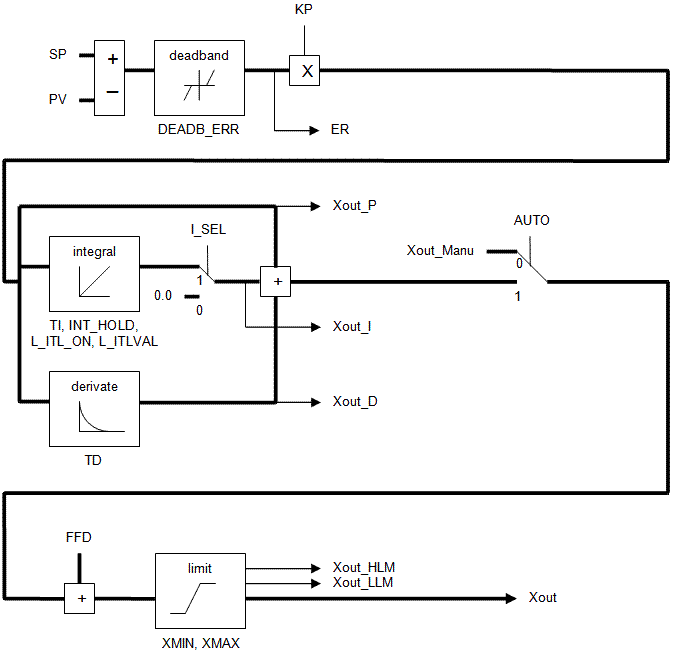
![]() A function block groups an algorithm and a set of private data. It has inputs and outputs. - PID
A function block groups an algorithm and a set of private data. It has inputs and outputs. - PID![]() "Proportional-Integral-Derivative"
A PID controller is a generic control-loop feedback mechanism widely used in industrial control systems.
An "error" occurs when an event or a disturbance triggers off a change in the process variable.
A PID controller attempts to correct the error between a measured process variable and a desired setpoint by calculating and then outputting a corrective action that can adjust the process accordingly loop
"Proportional-Integral-Derivative"
A PID controller is a generic control-loop feedback mechanism widely used in industrial control systems.
An "error" occurs when an event or a disturbance triggers off a change in the process variable.
A PID controller attempts to correct the error between a measured process variable and a desired setpoint by calculating and then outputting a corrective action that can adjust the process accordingly loop
For more details on regulation, see "Regulation".
Inputs
| Input | Type | Description |
|---|---|---|
| AUTO | BOOL | TRUE = normal mode , FALSE = manual mode. |
| PV | REAL | Process value. |
| SP | REAL | Set point. |
| Xout_Manu | REAL | Output value in manual mode. |
| KP | REAL | Gain. |
| TI | REAL | Integration time factor. A value of zero will stop the integrator and freeze Xout I at the previous sample’s calculated value. |
| TD | REAL | Derivation factor. |
| TS | TIME | Sampling period. |
| XMIN | REAL | Minimum allowed output value. |
| XMAX | REAL | Maximum output value. |
| I_SEL | BOOL | If FALSE, the integrated value is ignored. |
| INT_HOLD | BOOL | If TRUE, the integrated value is frozen. |
| I_ITL_ON | BOOL | If TRUE, the integrated value is reset to I_ITLVAL. |
| I_ITLVAL | REAL | Reset value for integration when I_ITL_ON is TRUE. |
| DEADB_ERR | REAL | Hysteresis on PV. PV will be considered as unchanged if greater than (PVprev - DEADBAND_W) and less that (PRprev + DEADBAND_W). |
| FFD | REAL | Disturbance value on output. |
Outputs
| Output | Type | Description |
|---|---|---|
| Xout | REAL | Output command value. |
| ER | REAL | Last calculated error. |
| Xout_P | REAL | Last calculated proportional value. |
| Xout_I | REAL | Last calculated integrated value. |
| Xout_D | REAL | Last calculated derivated value. |
| Xout_HLM | BOOL | TRUE if the output value is saturated to XMIN. |
| Xout_LLM | BOOL | TRUE if the output value is saturated to XMAX. |
Diagram

Remarks
- It is important for the stability of the control that the TS sampling period is much bigger than the cycle time.
- Output of the PID block always starts with zero. The value will vary per the inputs provided upon further cycle executions.
- The output rung has the same value as the AUTO input, corresponding to the input rung, in the FFLD language.
ST Language
(* MyPID is a declared instance of PID function block *)
MyPID (AUTO, PV, SP, XOUT_MANU, KP, TI, TD, TS, XMIN, XMAX, I_SEL, I_ITL_ON, I_ITLVAL, DEADB_ERR, FFD);
XOUT := MyPID.XOUT;
ER := MyPID.ER;
XOUT_P := MyPID.XOUT_P;
XOUT_I := MyPID.XOUT_I;
XOUT_D := MyPID.XOUT_D;
XOUT_HLM := MyPID.XOUT_HLM;
XOUT_LLM := MyPID.XOUT_LLM;
FBD Language
FFLD Language
(* ENO has the same state as the input rung *)
IL Language
(* MyPID is a declared instance of PID function block *)
Op1: CAL MyPID (AUTO, PV, SP, XOUT_MANU, KP, TI, TD, TS, XMIN, XMAX, I_SEL, I_ITL_ON, I_ITLVAL, DEADB_ERR, FFD)
FFLD MyPID.XOUT
ST"Structured text" A high-level language that is block structured and syntactically resembles Pascal XOUT
FFLD MyPID.ER
ST ER
FFLD MyPID.XOUT_P
ST XOUT_P
FFLD MyPID.XOUT_I
ST XOUT_I
FFLD MyPID.XOUT_D
ST XOUT_D
FFLD MyPID.XOUT_HLM
ST XOUT_HLM
FFLD MyPID.XOUT_LLM
ST XOUT_LLM







